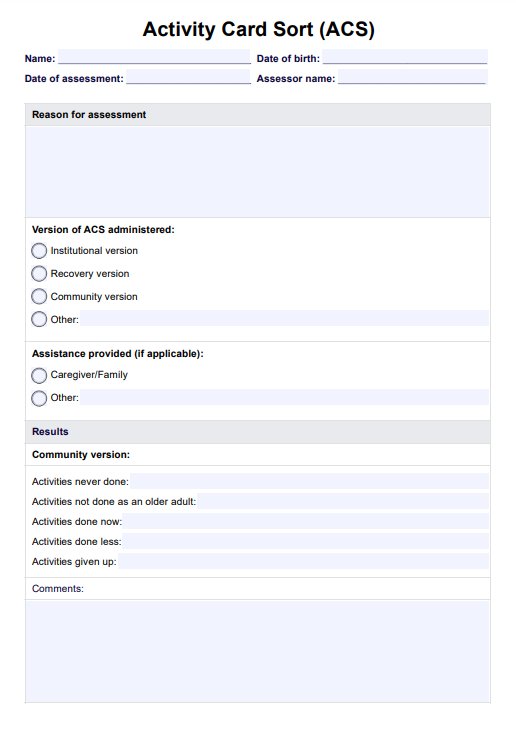The Activity Card Sort (ACS) is a widely used tool in occupational therapy international practice to assess occupational participation in instrumental, leisure, and social activities. Its initial development focused on evaluating activity engagement in both healthy adults and individuals with health conditions. The tool has strong psychometric properties, including excellent internal consistency and test-retest reliability, ensuring it provides accurate and consistent results.The structured test description ensures therapists can administer it effectively, allowing clients to describe their participation meaningfully, supporting tailored interventions.

Activity Card Sort
Download our free Activity Card Sort (ACS) template for seamless documentation, tracking occupational participation, and supporting meaningful client care.
Activity Card Sort Template
Commonly asked questions
The ACS is suitable for a broader population, including healthy older adults, those in recovery from illness, and individuals with conditions such as multiple sclerosis. It is particularly beneficial for community-dwelling older adults who may experience changes in daily living routines. By focusing on occupational participation, the ACS helps occupational therapists support individuals across diverse life situations, ensuring interventions are tailored to meet each client’s needs.
The ACS evaluates participation in leisure activities, social activities, and instrumental activities. It includes categories such as low physical demand leisure (e.g., reading or knitting) and high physical demand leisure (e.g., hiking or gardening). By using activity cards, clients sort activities based on their level of participation, allowing therapists to assess both low demand leisure and more active demand leisure activities. This process helps identify areas of focus for intervention and rehabilitation.
EHR and practice management software
Get started for free
*No credit card required
Free
$0/usd
Unlimited clients
Telehealth
1GB of storage
Client portal text
Automated billing and online payments











